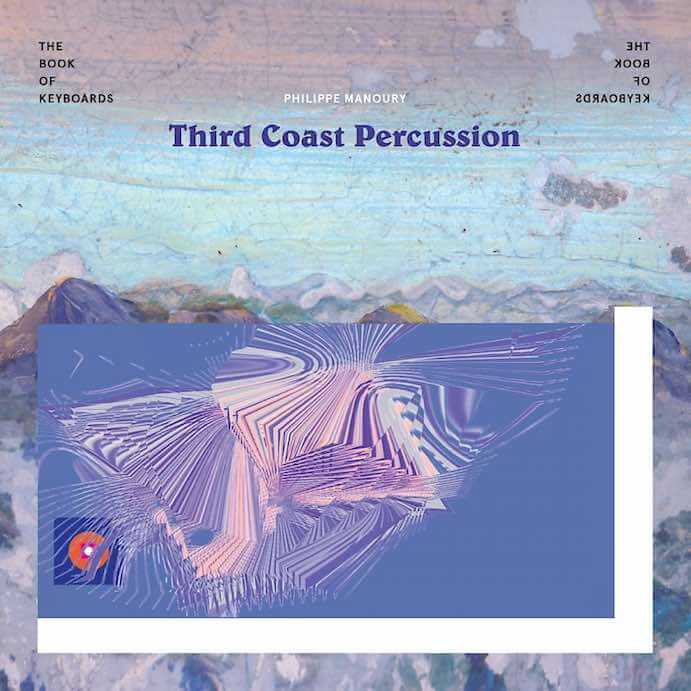The CD case of Third Coast Percussion’s new album on New Focus Recordings of music by Philippe Manoury, The Book of Keyboards, is just as intricate and fascinating as the music itself inside. The thick paper cover opens up like a puzzle, with different fonts and graphic designs revealed with each unfolded layer. This is the work of Sonnenzimmer, a Chicago based art studio run by Nick Butcher and Nadine Nakanishi, and is the first clue as to the care and attention Third Coast Percussion has taken in all aspects of this aural “book.” Both the six movement Le Livre des Claviers (The Book of Keyboards) and the final piece on the CD, Métal, take the listener on a journey into a world that is alternatingly chaotic—filled with kinesthetic energy and bursting with a kaleidoscope of metallic color—and meditative; melodically brooding around compositional concepts.
Third Coast Percussion’s abilities as soloists and as a group mean that their commissioned composers can write for a virtuosic level of player in their pieces. Though the French composer Philippe Manoury didn’t write The Book of Keyboards for Third Coast Percussion, his visionary style and demanding writing makes this pairing of writer and performer a good match from the beginning. Born in 1952, Manoury studied at the Ecole Normale de Musique de Paris and Paris Conservatory before joining IRCAM as a composer and electronic music researcher in 1980. His oeuvre is massive; operas, concertos, chamber music, and orchestral pieces are all well represented. From the works on this album, you could correctly guess that his aesthetic is deeply influenced by Pierre Boulez and Iannis Xenakis, and visual artists like Jackson Pollock.

Third Coast Percussion– Photo by Saverio Truglia
Manoury’s music in both The Book of Keyboards and Métal make a big ask of musicians when it comes to procuring the actual instruments necessary for performance. Robert Dillon’s clear and engaging liner notes describe how these works are scored for sixxen, “a set of six instruments which must be built from scratch,” and originally imagined by Xenakis who specified their sonic parameters but never made specific designs. Looking like a large 19-note keyboard made of straight-from-Home-Depot materials (think thick metal sheeting and wood 2 by 4s), each of the six sixxen is purposefully out of tune with the others, which leads to the palpable rainbow of tonality that is generated by these pieces. Their function all together as one instrument immediately brings to mind the workings of a Gamelan, but the collective sound of the six DIY instruments reminds me of a much different sound: the large wind chimes my mother hung on the back porch of our house during my childhood.
The chime-like sixxen easily produces the vibrant and bombastic sonic textures that nearly overstimulate the mind in movements 3 and 6 of The Book of Keyboards, but this is well-balanced with movements like #4, where Peter Martin’s performance of this pensive, delicate music is both tender and exacting. The second movement, a duo performed by Robert Dillon and David Skidmore, is humorous and obstinate, the lines of their parts chasing each other, at times a well-placed tremolo suggesting a thumbed nose or a tongue stuck out in jest. Manoury’s own program notes describe the sixth movement as a play on the notion of “thickness of sound,” with homorhythmic sequences, polyrhythmic textures, and an increasingly deepening world of sounds vacillating the music between the simple and the complex.
Philippe Manoury
The album ends with Métal, also for sixxen. Here, Manoury uses events of different energy levels to create a compelling musical structure. Changes between moods and texture happen in an instant, and even forceful, exuberant moments are handled with delicacy and control. The sixxen’s ever-present resonance is what makes it sound like an enthusiastic chorus of wind chimes dancing from the rafters of a front porch in a storm, but the endlessly ringing nature of this instrument is also what makes it tricky to play: if the unison mallet-work isn’t completely unison, and if the balance between performers weren’t carefully thought out in rehearsal, the music would quickly become a muddy mess and Manoury’s intricate lines blurred beyond repair. For this reason, Métal’s 22-minute journey into the many facets of the sixxen sound brings to stark relief the perfection with which Third Coast Percussion plays. The delicate complexities of this music would be lost in an instant if the performers were not playing with a fathomless focus.
With each listening, the music on this album becomes easier to “see.” The rainbow of sixxen sound separates itself into all different shades of color, the musical structures become progressively visible, and the methodical manner of Manoury’s writing comes into sharp focus. Though the very nature of writing for instruments that only exist now in a few places on earth makes performances of the music on this album by other percussion ensembles quite impossible for everyone outside the uber-enthusiastic (and those with excellent carpentry skills), knowing these pieces and seeing the work that has been put into Third Coast Percussion’s performance is excellent motivational fodder for any percussion group looking to expand their knowledge of repertoire and improve their handling of substantially demanding music. Truly, Third Coast Percussion had the right idea with the packaging here; just as the wrapping of the CD opens up like a puzzle, so too does their presentation of this music present the many layers of Manoury and his sixxen as a riddle that can be solved with careful unfolding.


